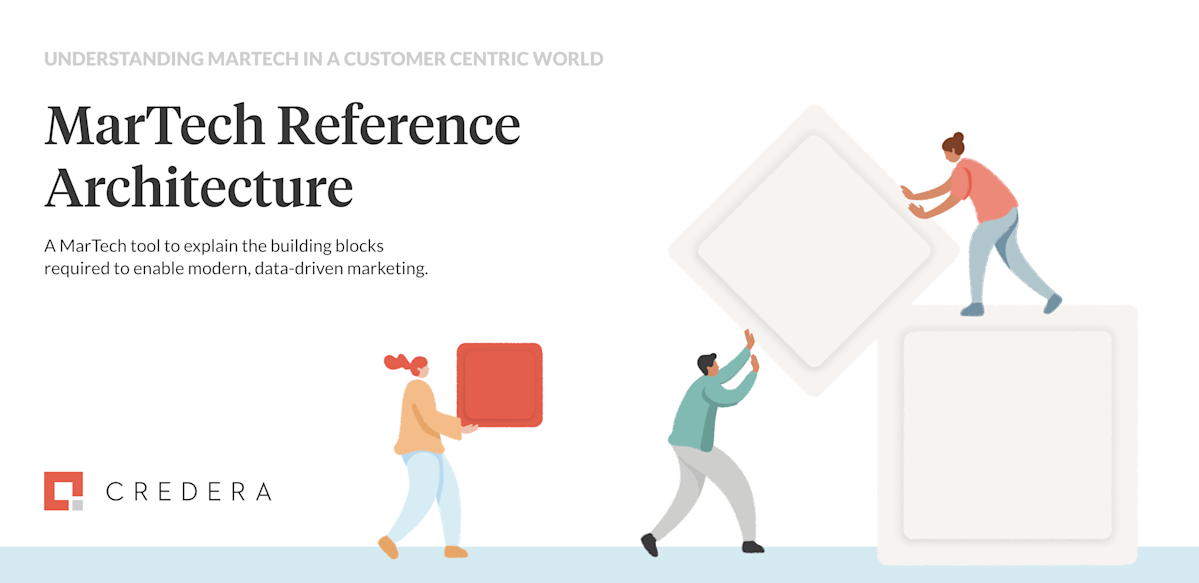Technology
Sep 24, 2024
Credera’s MarTech Reference Architecture part 6: AdTech trends, players, & measurement

In this installment of the MarTech reference architecture series, we will focus on advertising technology, or AdTech, a key capability needed to broaden your marketing reach and increase your overall customer base. In this article, we will walk through how to use AdTech to target prospective customers with the right messaging at the right time and review some of the challenges facing advertisers.

What is AdTech?
AdTech refers to the technology and processes responsible for advertising and marketing via paid channels (e.g., display, search, social, video, etc.). While customer relationship management communications (e.g., email, SMS) market to known customers, paid media strategies are typically relied on to generate demand and acquire new customers. Marketing to unknown potential customers relies heavily on data modeling and propensity indicators that serve to provide buying signals, namely intent. Therefore, access to rich data sets is crucial in deploying effective paid marketing campaigns that optimize positive outcomes and minimize wasteful spending.
Why AdTech matters
U.S. advertising spending for 2020 is forecasted at $177 billion (57% digital) with 2025 spending forecasted at $270 billion (65% digital). In 2019, the average marketing budget for firms in North America and the UK represented about 10.5% of firm revenue; approximately a quarter of this budget went to media. Therefore, optimizing media spend should be of strategic importance for both the chief marketing officer (CMO) and CEO.
A brand’s AdTech stack should enable marketers to target individuals across channels, deliver relevant and contextual messages at the right time, and support the measurement and reporting of business outcomes associated with advertising—all while respecting individuals’ privacy concerns.
Top technologies & players

5 keys for driving AdTech maturity
The exact characteristics of a mature advertiser will vary across industries, but consider these recommendations below for how to advance AdTech maturity and improve operational efficiencies.
1. Omnichannel advertising
Omnichannel advertising is not just executing cross-channel campaigns, but instead represents a shift away from channel-specific planning, execution, and reporting to advertising strategies that are aligned to the individual’s own customer journey. Mature omnichannel advertisers manage reach and frequency, execute sequencing and personalization, and create activation and suppression audiences through unified processes that are managed across their digital channels. These advertisers effectively use the right channel for each individual at the right time and optimize media spend across channels instead of in channel specific silos. This shift requires advertisers to align their teams, processes, and technology to the customer journey instead of to individual channels.
2. Data management and strategy
A well-defined data strategy is key in advertising. Data deprecation has and will continue to present challenges for marketers; while there is no single solution, an understanding of the data currently available and what data sets are and are not being utilized is key. This understanding of data will help position firms to achieve their marketing objectives and enable the appropriate pivot when data deprecation impacts specific media strategies. Data deprecation largely impacts third-party data, so many brands have chosen to place a greater reliance on first-party data.
3. Automation
Credera believes there is significant opportunity to improve efficiencies and outcomes through the automation of manual, repetitive tasks. There are opportunities throughout the advertising lifecycle from planning to spend reconciliation.
While automation is typically seen through the lens of cost, Omnicom Media Group’s CEO Scott Hagedorn recently spoke of automation through the lens of attracting talent, “I want to try to root out as many route jobs and route processing jobs as we can so that for folks who are joining from an entry level perspective, they get to contribute their ideas and their thinking into the client’s business challenges.” Scott went on to explain that automating repetitive tasks would make the entry-level positions Omnicom Media Group has to offer more desirable and would help the firm attract the best young marketing talent.
4. Partner rationalization
Marketing agencies and technology products/partners each take approximately a quarter of CMOs’ budgets. A good practice is for advertisers to periodically evaluate the effectiveness and role of their partners (e.g., agencies, technology partners, platforms, etc.).
Historically, brands have relied on agencies to manage their AdTech stack. Many organizations are now facing pressure to take greater control of their data and associated technology stack over security and privacy concerns. Greater control of the technology stack also enables firms to better integrate their AdTech, MarTech, ecommerce, and product technology.
A shift toward omnichannel advertising can present opportunities for technology consolidation. As channel-specific teams transition to an omnichannel structure, redundant systems may be identified. Finally, CMOs are also facing pressure to evaluate bringing creative and media execution in-house, a trend that Credera expects to continue in 2021.
5. Framework for optimizing marketing ROI
Full-funnel reporting should be a strategic priority for a modern marketing organization. Traditional media metrics such as reach, frequency, and cost are helpful, but modern marketers should work with their teams to develop KPIs specific to their business objectives. Unified measurement models help marketers understand the impact of media throughout the funnel—it’s key to optimization.
Current trends & considerations
The media landscape, consumer preferences, and regulatory statutes are constantly changing. While this can be overwhelming, it’s important to keep a pulse on current trends. Consider these trends and how they may have an impact on your AdTech stack and marketing strategy.
Consumers desire privacy
Forrester reports that “more than 60% of U.S. online adults are unwilling to let companies track their location or activities across devices or share their personal information in exchange for more relevant ads.” While a certain level of personalization is enjoyed by individuals, many individuals find the current level of personalization creepy. Individuals are acting upon their desire for privacy as 49% of U.S. online adults have taken measures to limit the collection of their personal data.
Data deprecation
Technology companies have responded to increased demand for privacy. Safari, Firefox, and Edge currently block third-party cookies as the default setting and Chrome announced this year they will remove third-party cookies from their browser as well. Starting with iOS 14, iPhone users will need to grant publishers the right to track their online activity using the IDFA (Identifier for Advertisers), Apple's mobile advertising ID. Regulators have also responded—a key component of the General Data Protection Regulation (GDPR) and the California Consumer Privacy Action (CCPA) is that individuals can request brands delete the personal information they have on the individual.
These recent changes on top of the fact that Google, Facebook, and Amazon are all walled gardens means significant disruption for advertisers. Brands’ ability to target individuals, personalize content, and analyze attribution is expected to be impacted.
Mobile
In 2018, Hearts & Science reported that “people spend five hours every day across all mobile apps and people interact with them 88 times per day.” It should not be a surprise that in 2020, mobile represented the majority of digital media spend in the U.S. (64%).
This channel does present some unique challenges. The smaller screen size can increase the frustration associated with ads, so advertisers and agencies must be format aware and ensure content does not interrupt the user experience. Furthermore, iOS 14 will limit advertisers’ ability to market on iOS platforms due to changes to the IDFA, and self-reporting networks (SRNs) present challenges associated with attribution for mobile app products.
Media consumption
The average U.S. adult consumes more than 12 hours of media a day. Audience reach for smartphone-based audio streaming increased 28% year over year and time spent on video streaming increased 74% year over year.
While more long-standing channels such as TV, search, social, and display represent the majority of spending, newer channels such as podcasts, OTT, CTV, esports, and TikTok saw significant growth this year.
Moving forward
There is no one-size-fits all AdTech stack; instead, brands and their partners must thoughtfully approach their technology stack with an understanding of their customer, business objectives, and data. Learn about how Credera partnered with a network streaming service to improve media outcomes.
Overview of articles in the series:
Part 6: AdTech & Attribution
Interested in learning more about Credera’s experience and service offerings related to AdTech and attribution? Reach out to Credera to start a conversation.
Contact Us
Ready to achieve your vision? We're here to help.
We'd love to start a conversation. Fill out the form and we'll connect you with the right person.
Searching for a new career?
View job openings





